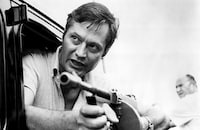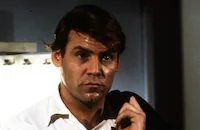Von Richthofen and Brown

Brief Synopsis
Cast & Crew
Roger Corman
John Phillip Law
Don Stroud
Barry Primus
Corin Redgrave
Karen Huston
Film Details
Technical Specs

Synopsis
In 1916 in the second year of World War I, Manfred von Richthofen, a former cavalry officer turned air pilot, joins Jagdstaffel 2, under the command of renowned flying ace Maj. Oswald Boelcke. The other pilots, including Ernst Udet, Werner Voss and Hermann Göring, are taken aback by the newcomer's steely arrogance and ambition. Soon after, Richthofen shoots down his first enemy plane, a French Nieuport. Exalted, Richthofen makes a wild dive in order to land quickly and drive a car out to the wreckage of the French plane where he inspects the dead pilot and cuts the French emblem out of the plane's canvas as a trophy. Later, Boelcke scolds Richthofen for reckless flying that might have damaged the plane and assures the younger pilot that he will never forget any of his victims. Noting Richthofen's genuine flying skills, Boelcke teaches him combat technique and soon Richthofen vies with his commander in ability and tactics. The Germans next fly against British squadron 24, led by Commander Owen and Victoria Cross winner Maj. Lanoe Hawker. After the mission, the British welcome a group of new pilots, which includes Canadian Arthur Roy Brown. Brown immediately offends Hawker the first evening by dismissing the traditional "gentleman's toast" to Richthofen. Brown declares the German their enemy and insists that he would rather salute Richthofen's noble victims. At Jagdstaffel 2, Richthofen's younger brother Lothar joins the squadron and admires his brother's growing collection of tiny silver trophies commemorating each downed enemy plane. A few weeks later during a mission, Richthofen makes an aggressive air attack, flying directly at a British craft, but accidentally clips Boelcke's plane's tail, sending it spinning out of control and crashing. Although initially shocked, Richthofen grows angry and quickly shoots down a British plane, then turns on Hawker's craft and shoots him in the head. On the ground, Göring furiously chastises Richthofen and suggests that his boldness is due to his upper class status. Meanwhile, at British squadron 24, Brown grimly salutes Hawker at the dining table as the other pilots remain seated. Soon after Boelcke's funeral, the twenty-three-year-old Richthofen is appointed the new commander of an elite squadron, Jasta 11. Over the next several weeks, Richthofen continues to build his reputation as a singular flying ace and receives the coveted Orden Pour le Mérite , or the Blue Max. Upon receiving an order to paint the squadron planes multi-colored to obscure the aircraft's style, Richthofen impulsively has the men paint their planes bright, vibrant colors and paints his own Albatros D.III bi-plane bright red. When the German High Command arrives at Jasta 11 with several journalists, they are shocked by the colored planes, but the press enthusiastically dubs Richthofen's squad The Flying Circus. Jasta 11 continues its successful campaign, making an unprecedented attack on British 24's camp during an afternoon cricket match. Soon after, Richthofen is summoned to Berlin to receive a decoration from Kaiser Wilhelm. During a party, Richthofen meets Dutch aircraft manufacturer Anthony Fokker, who shows him his latest design, a tri-plane. Meanwhile, Brown continues to anger Owen and his fellow pilots by insisting that the Germans are refusing to "play by the rules" and they should behave similarly. In the next air battle, Göring shoots down Brown, who manages to land safely and exit his plane before it explodes. While pausing to watch his friend Voss being shot down, Richthofen is caught unawares by a plane behind him and receives a grazing shot to the head, forcing him to crash-land near the front line. British infantry troops attempt to reach the famed red plane, but are held off by Germans and the injured Richthofen is rescued and later sent home for several weeks to recover. At Squadron 24, Brown, fellow Canadian Lt. Wilfred "Wop" May and Briton Murphy convince Owen to make a retaliatory raid against the Germans at the dinner hour. The raid is a success, destroying numerous grounded planes, personnel and an ammunition dump. Lothar is wounded in the leg while trying to take off in his plane. At the British debriefing, Owen is shocked when the men report the German infirmary was struck, but an officer from headquarters states that new orders have been issued for British flyers and troops to match the Germans in brutality. A little later, Richthofen returns to Jasta 11 to find a new group of Fokker planes, and his own tri-plane, the Fokker Dr.I, again painted bright red. Although Richthofen suffers some memory loss from his recent head wound, he appears strong and calls for an attack on the British camp. During the ensuing assault, Göring enrages the British by strafing a group of nurses fleeing the assault. Later, Richthofen takes Göring to task for the indiscriminate attack and threatens to shoot him if he repeats the behavior. The war proceeds over several months, with both sides incurring heavy losses and each group of pilots growing increasingly weary and bitter. When America enters the war, the British receive numerous American pilots as replacements, but their eagerness irritates Brown who promptly starts a fight with several. Meanwhile, Richthofen is stunned when the High Command summons him to confide that the war is lost for Germany and pressure him to accept a safe instructor's position. Outraged, Richthofen refuses. Returning to the airfield, Richthofen receives a letter from his private jeweler stating that as silver is no longer available in Germany, his future trophies will have to be made of tin. In April 1918, Jasta 11 and British 24 clash again in the air, flying near the Somme. When Richthofen forces May to land his damaged plane, Brown takes the opportunity to chase the low-flying Richthofen over the river and treetops, the pilots trading places back and forth as hunter and hunted. Brown doggedly stays with Richthofen and after swinging behind the German's plane, fires a burst, killing the famed ace. Returning to the British field, Brown is wildly congratulated for his victory, while Jasta 11 mourns the death of their most famed pilot and Göring is made the new commander.

Director

Roger Corman
Cast

John Phillip Law

Don Stroud
Barry Primus
Corin Redgrave
Karen Huston

Hurd Hatfield
Stephen Mchattie
Brian Foley
Robert La Tourneaux
Peter Masterson
Clint Kimbrough
Tom Adams
Ferdy Mayne
David Weston
John Flanagan
Lorraine Rainer
Brian Sturdivant
Maureen Cusack
George Armitage
Gordon Phillips
David Osterhout
Seamus Forde
Fred Johnson
Des Nealon
Emmet Bergin
Peadar Lamb
Vernon Hayden
Michael Fahey
Robert Walsh
Crew
Peter Allwork
Charles Boddington
Terry Cole
Alan Collins
Seamus Corcoran
Gene Corman
John William Corrington
Joyce H. Corrington
Peter Dawson
Toni Delaney
Lynn Ellsworth
Hugo Friedhofer
Noel Gallagher
Lynn Garrison
Charles Guerin
Julie Halloran
Paddy Keogh
John Maher
Peter Manley
Dymphna Mckenna
Redmond Morris
Jimmy T. Murakami
Jimmy T. Murakami
William O'kelly
Peter Pechowski
Michael Reed
Maureen Roche
Liam Saurin
Neil Siegler
George Van Noy
Hilary Wardrop
Jake Wright

Film Details
Technical Specs

Articles
Von Richthofen and Brown -
By Richard Harland Smith

Von Richthofen and Brown -
Quotes
Trivia
One of the stunt flyers was Richard D. Bach, the pilot and author of Jonathan Livingston Seagull (1973).
Reused the vintage airplanes from Blue Max, The (1966).
Director Roger Corman's soon-to-be wife, Julie Halloran, filled in as a gunner in one of the planes during the raid sequence when the production came up one actor short.
Production was shut down briefly due to a disaster on another semi-related film in the area. Birch Williams, an American living expat in Ireland, was the owner of the period planes Corman leased for the production. He was so interested in and excited by what Corman was doing that he decided to make a similar film himself, using his own planes. Unfortunately, there was a midair mishap, and Williams and two pilots were killed. In response, the Irish government shut down all film flying, and the insurance company cancelled Corman's policy. It took several days of negotiation to get their status restored, and to resume production.
While the dogfights were shot in Ireland over a two-week period using actual vintage planes, the crash sequences were filmed at Andrews Air Force base in a single day, using models assembled by a group of teenaged hobbyists Corman happened across while scouting locations.
Notes
Filmfacts indicated that a love scene between "Manfred" and "Else" was cut after a West Coast preview which May account for the varying running times. A Hollywood Reporter news item from early 1970 indicated that Von Richthofen and Brown would be shot on location in Munich. However, as Variety reported in a March 1970 article, shooting had been set at Ireland's Ardmore Studios where the popular 1966 Twentieth Century-Fox World War I feature, The Blue Max was filmed. A September 1970 Daily Variety item reported that stunt pilot Charles Boddington was killed during a crash during production. Filmfacts stated that the Irish government was forced to ground the twelve planes used for the aerial sequences being filmed at Weston Airfield near Dublin after Boddington's fatal crash and another the next day when pilot Lynn Garrison and actor Don Stroud, as "Arthur Roy Brown," suffered minor injuries after crashing into the Liffey River. Modern sources add Julie Corman to the cast.
Manfred von Richthofen (1892-1918) was Germany's greatest air pilot during World War I, credited with a record eighty enemy aircraft kills. Known variously as "der rote Kampfflieger" by the Germans, "le petit rouge" by the French and "the Red Baron" by the British and Americans, the famed ace was twenty-five years old at the time of his death in April 1918. Although Richthofen is generally portrayed flying the famous red Fokker Dr.I tri-plane, during most of the war he flew the Albatros bi-plane D.II and D.III that were only partially painted red.
As shown in the film, Maj. Oswald Boelcke (1891-1916), credited with forty enemy kills, served as Richthofen's mentor as well as commanding officer until his death. The film depicts Richthofen as responsible for the accident that led to Boelcke's death, but the incident also involved pilot Erwin Boehme, who actually collided with Boelcke's craft. Although the chronology of some events was changed for continuity, the film is historically accurate in many respects. Hermann Göring (1893-1946), who was later appointed Reichmarshal by Adolf Hitler and the head of the German Luftwaffe during the Third Reich, was a member of Richthofen's Jasta 11 and, as shown in the film, was made its commander upon Richthofen's death.
As the film indicates, Canadian Anthony Roy Brown (1893-1944) was officially credited with bringing down Richthofen. However, some years after the end of the war, through autopsy reports and numerous investigations into Richthofen's death it was concluded that the fatal shot that killed the flying ace did not come from Brown's Sopwith Camel guns, but from an Australian machine gunner on the ground.

Miscellaneous Notes
Released in United States 1971
Released in United States 1971













